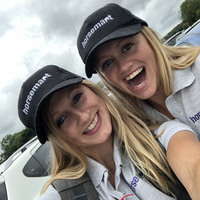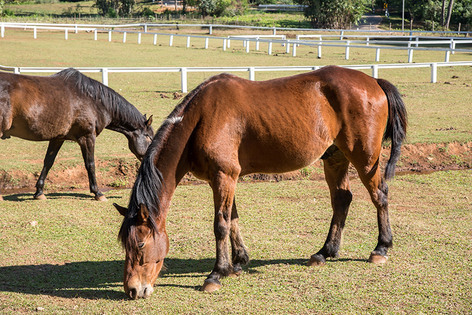
Are You & Your Horse Ready For Bitting Advice? The Steps You Need To Consider First
Equestrian Advice & Guides All Disciplines
Build your business profile for FREE and expose your services to thousands of potential clients!
Create my profile now!
For a long time, the horse world has been more concerned by underweight horses than overweight – that picture of the obese horse just doesn’t tug on the heart strings the way the ‘poor, skinny soul’ does. Despite this, the facts remain that it is simply less dangerous for the horse to be underweight than overweight; it has many less far-reaching implications. However, an underweight horse still isn’t desirable in any way as it makes it difficult for them to carry the weight of a rider and/or equipment, and it can cause nutritional deficiencies with long-reaching consequences. Not to mention the fact that it can lead to a lot of judgement, particularly in a yard scenario, or if horses are near a public thoroughfare.
Keeping an eye on your horse or pony’s weight is absolutely essential. Your horse won’t stay exactly the same weight all the time – there are so many influencers. Being able to recognise the signs that your horse has lost weight can be challenging, but having an awareness of your horse’s ideal shape will help a great deal. Ask for unbiased advice (preferably steering clear of the internet) and do some research (older books are better; horses in general tend to be much fatter these days). Obviously, a weighbridge is massively helpful, but a weigh tape works well to make comparisons from week to week, and a visual condition score can give you lots of information and is the best way to understand what the best weight for your horse is.
For more information about how to calculate the weight of your horse, please see ‘What Is The Average Weight Of A Horse?’

First of all, you should be aware that the type of horse will make a lot of difference to how much weight they should carry; for example, an event horse will look a lot different to a dressage horse. Ideally, the horse should have a smooth junction from whither to back, and should have a flat back without the spine raised. For most horses, a good sign they are losing weight is when you can start to see ribs, although some horses will lose weight from their top line first, and may develop a pointy bum from losing muscles on their quarters.
There are many possible reasons a horse may struggle to maintain their weight. Horses’ teeth need regular maintenance, every six months to a year. If they are dropping food or have unusually bad breath, these are signs that they need their teeth doing. Worms are the next things to check for – get a worm count done from their poo and worm accordingly. Don’t forget, they will also need a saliva test for tapeworm twice a year! Management and routine can also affect horses a great deal, they get stressed easily, and losing a friend or changing yards or fields could easily have a detrimental effect. Cold is another factor; horses can struggle to maintain their body temperature, particularly if clipped, so putting a heavier rug on or an extra layer can often benefit them. This applies particularly in the stable – people tend to forget that horses will generally need heavier layers in the stable than the field, as they can’t move around as much. Finally, making sure your horse gets the right amount and the right type of feed for the amount of work he or she is in.
What to feed is often a bit of a minefield for people. There are so many brands, different feeds, supplements, and some people swearing by products that don’t help other people at all. Try to keep it simple and only take advice from people who have similar horse types to you. Trial and error is your friend here, but remember to change feeds very gradually, and give each feed a good chance.
Start with forage – if your horse is underweight it is best to allow adlib forage at all times, including in the field. Make sure your hay or haylage is good quality, and preferably not in too small a holed net, so they can eat it quickly. We find a 16hh horse will need three large haynets to keep them going throughout the night and in order to have leftovers. Horses should never run out of hay or haylage in the stable, whether they are fat or thin. They are grazing animals which means that they have to keep their gut constantly moving to stay healthy.
For hard feed, start with a good quality chaff – we feed a much more expensive chaff, and more of it, than a lot of people, but focus far less on additives. A conditioning mix is a good addition, and an additional source of protein such as linseed (which you can feed in high quantities). Ask for nutritionists advice, but be aware they are nearly always affiliated with a company and ultimately want to sell you more feed.

Supplements to help with fat or muscle gain can also be added. We routinely use Protexin Gut Balancer with our horses. This is particularly helpful for horses who need to gain weight. Because it contains pre and probiotics, the balancer helps to reseed the gut and aids the amount horses can absorb. The two horses featured in the body of this article were 30 and 26 in the pictures. The year before these were taken, both horses were on four feeds a day and still looking poor. It’s understandable that older horses can look poor, but that doesn’t mean that they have to be. We switched them onto gut balancer and saw a huge difference in both of them. It might not help every horse but there is something out there that will.
To find out more about what and how much to feed your horse, please see ‘The Basics Of Equine Nutrition – Feed Levels, Nutrient Requirements & Diet Change’.
Be careful with work whilst your horse is underweight. That doesn’t mean you can’t work them at all but it may be useful to switch them to groundwork whilst building up their condition. Groundwork is always helpful at any stage, but as long as your horse is capable of carrying you, light work will help the muscles to build correctly. If unsure, please ask for veterinary advice, and chiropractors and physios will also be able to help you with how effectively your horse is gaining muscle. The most important thing is to make sure you’re feeding more calories than your horse is burning off. With our retired oldies, we like to do two sessions of gentle groundwork (even if that consists of walking around the arena once in hand) each week to give them the muscle needed to support their bodies. Turnout is also brilliant for horses, they will naturally move around when grazing, and this can be encouraged by situating their water and hay a distance apart to encourage gentle exercise.
Try not to worry. Horses can lose weight very quickly and it often takes a long time to gain it back. This is normal – and can be stressful – but be aware of any progress, and if there are any backwards steps, try to ascertain why. Good luck, we hope you’re all well.
If you're worried that your horse may be overweight rather than underweight, please see our article 'Obesity In Horses - How To Tell If Your Horse Is Overweight & Help Them Lose The Pounds!'

